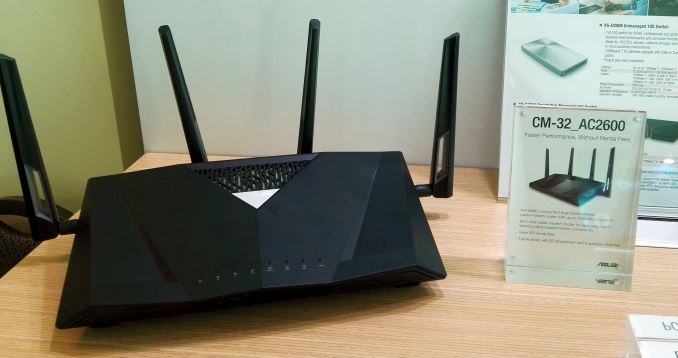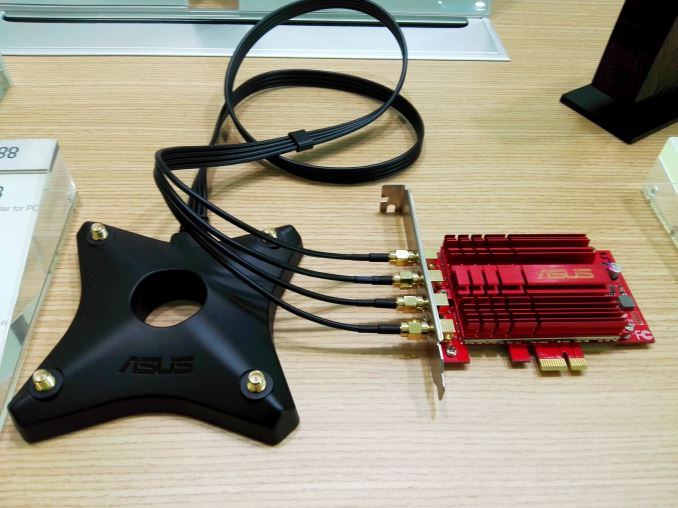ASUS Booth Tour at CES 2016: 10G Switches, External GPU Dock, USB-C Monitor and more
by Ian Cutress on January 19, 2016 9:00 AM ESTAside from the 10GBase-T switches written about earlier (they were actually hidden more in the B2B part of ASUS’ booth complex), the march on wireless is still one of ASUS’ marketing angles. Anyone who has looked into new routers or WiFi connection points can’t help but have noticed the swathe of ASUS routers now available, from single stream 802.11n USB sticks all the way up to 4x4 dual band 802.11ac MU-MIMO capable hardware.
Networking
ASUS had on display the AC2600 cable modem router, which offers 4x4 MIMO support, which can provide better coverage than the current generation of 3x3 models. I find it mildly interesting that it lists up to 2.53 Gbps support, although this will be shared between connected units and the gigabit Ethernet network ports on the rear might be a bottleneck to peak speed. That being said, the only time peak speed would be needed is for file transfer or multiple streaming.
To go with this, because there are no 4x4 on-motherboard solutions currently out, ASUS also had a PCIe wireless networking card which supports 4x4 802.11ac for up to 3.1 Gbps theoretical speed.
ASUS put a big heatsink on this card to help it keep cool under load, and the unit is massive. That being said, similar to other ASUS units, it is magnetic and thus will allow most users to affix it to the top or side of the PC chassis. Ultimately this is aimed at being the peak solution for when wires can’t make it.
Also on display was what ASUS was calling the first USB 3.0 based dual-band AC1900 WiFi point, capable of 3x4 MIMO and a flexible cable. In the USB format, this can be moved from machine to machine as well as not taking up a PCIe 3.0 x1 port on the motherboard. No word on pricing or release date at this time.













50 Comments
View All Comments
WhisperingEye - Wednesday, January 20, 2016 - link
Panzerknacker- I don't understand why you replied to a phone question with a router question.Xajel - Sunday, January 24, 2016 - link
The main reason behind this is that most consumer devices hardly sustain the 1Gb connection.. only some extreme consumers like heavy media servers at home that serves multi 4K stream...so for a consumer, 1Gb is enough, and there's no devices that can make use of 10Gb for the consumer...
Some advanced/enthusiast users uses a Link Aggregation connection as a backbone of their network ( NAS -> Switch <- HTPC/Main PC ) so these can serve multi streams in the same time without any drops... but that is rare as 1Gb is enough for most users already...
Maybe pro users, like pro video editing needs these 10Gb links, but it's already rare situation to see this in a home user, a person with the need for 10Gb ethernet is already using high-end workstations with professional systems.. so it's not a consumer oriented product any more...
Personally I thought about having 10Gb as a backbone for my home network just to be future proof.. but after looking again.. I found it too expensive, and I can make 2x 1Gb Link Aggregation which much less cost and still serve me well for few years a head ( NAS + HTPC + router + Switch all with LA connections )
Lieuchikaka - Thursday, June 2, 2016 - link
http://mavangvn.vn/ma-vang-dien-thoai/dien-thoai-s...Lieuchikaka - Thursday, June 2, 2016 - link
http://mavangvn.vn/ma-vang-dien-thoai/dien-thoai-s...rhx123 - Tuesday, January 19, 2016 - link
Using their own standard instead of TB3 just screams of Vendor Lock-In, especially when TB3 can do 36gbps over an active cable.SirKnobsworth - Tuesday, January 19, 2016 - link
According to Tom's, they actually require 2 type C cables too.Alexvrb - Tuesday, January 19, 2016 - link
Your statement is ironic to me because thunderbolt is itself... a proprietary standard. For external graphics we really need a standardized "Type G" port or something that can provide all the bandwidth by itself. But that will probably never happen. For that matter, even a much tamer enclosure hosting "only" up to 150W GPUs would still be a huge boost for a laptop.nathanddrews - Tuesday, January 19, 2016 - link
So... what are the implications of USB-C displacing HDMI and DisplayPort connectors? I know that it technically is DP over alternate mode, but it's clearly very popular. It seems like many new displays have it built in. Adaptive Sync? Latency? Would there be a penalty of some kind for sending video output through the USB bus instead of directly from the GPU?My only experience is with a first-generation USB display that sucked immense balls.
SirKnobsworth - Tuesday, January 19, 2016 - link
It's just a multiplexer that sends the signal over unused pins. You only get two lanes (as opposed to the usual 4), but that's fine as long as you don't need 4k60.Ryan Smith - Tuesday, January 19, 2016 - link
You can get 4 lanes of DP. It just uses up all the differential pairs, so you have to give up USB 3.x to get it (which is why DP 1.3 is going to be such a big deal).